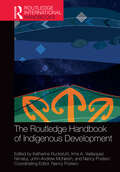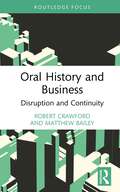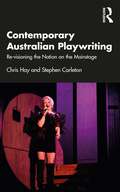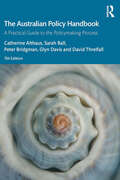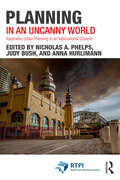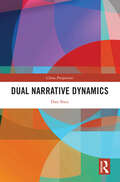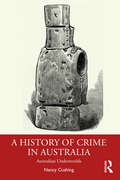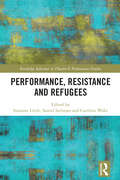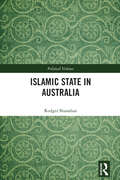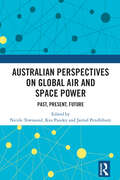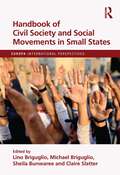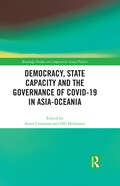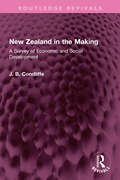- Table View
- List View
The Routledge Handbook of Indigenous Development (Routledge International Handbooks)
by Katharina Ruckstuhl Irma A. Velásquez Nimatuj John-Andrew McNeish Nancy PosteroThis Handbook inverts the lens on development, asking what Indigenous communities across the globe hope and build for themselves. In contrast to earlier writing on development, this volume focuses on Indigenous peoples as inspiring theorists and potent political actors who resist the ongoing destruction of their livelihoods. To foster their own visions of development, they look from the present back to Indigenous pasts and forward to Indigenous futures. Key questions: How do Indigenous theories of justice, sovereignty, and relations between humans and non-humans inform their understandings of development? How have Indigenous people used Rights of Nature, legal pluralism, and global governance systems to push for their visions? How do Indigenous relations with the Earth inform their struggles against natural resource extraction? How have native peoples negotiated the dangers and benefits of capitalism to foster their own life projects? How do Indigenous peoples in diaspora and in cities around the world contribute to Indigenous futures? How can Indigenous intellectuals, artists, and scientists control their intellectual property and knowledge systems and bring into being meaningful collective life projects? The book is intended for Indigenous and non-Indigenous activists, communities, scholars, and students. It provides a guide to current thinking across the disciplines that converge in the study of development, including geography, anthropology, environmental studies, development studies, political science, and Indigenous studies.
The Routledge Handbook of Indigenous Development (Routledge International Handbooks)
by Katharina Ruckstuhl Irma A. Velásquez Nimatuj John-Andrew McNeish Nancy PosteroThis Handbook inverts the lens on development, asking what Indigenous communities across the globe hope and build for themselves. In contrast to earlier writing on development, this volume focuses on Indigenous peoples as inspiring theorists and potent political actors who resist the ongoing destruction of their livelihoods. To foster their own visions of development, they look from the present back to Indigenous pasts and forward to Indigenous futures. Key questions: How do Indigenous theories of justice, sovereignty, and relations between humans and non-humans inform their understandings of development? How have Indigenous people used Rights of Nature, legal pluralism, and global governance systems to push for their visions? How do Indigenous relations with the Earth inform their struggles against natural resource extraction? How have native peoples negotiated the dangers and benefits of capitalism to foster their own life projects? How do Indigenous peoples in diaspora and in cities around the world contribute to Indigenous futures? How can Indigenous intellectuals, artists, and scientists control their intellectual property and knowledge systems and bring into being meaningful collective life projects? The book is intended for Indigenous and non-Indigenous activists, communities, scholars, and students. It provides a guide to current thinking across the disciplines that converge in the study of development, including geography, anthropology, environmental studies, development studies, political science, and Indigenous studies.
Oral History and Business: Disruption and Continuity
by Robert Crawford Matthew BaileyThis book introduces business historians to oral history methodologies and approaches. Using four distinct oral history case studies to explore ideas of disruption and continuity in business history over the second half of the twentieth century, Robert Crawford and Matthew Bailey demonstrate how critical engagement with oral history approaches serves to enhance and enliven business history as well as its relationship with other historical fields. The focus on disruption is used to encompass a broad set of processes such as technological change, the impact of external forces, informal business networks, social constructions of gender, knowledge transfer, firm adaptability and cultural change. The use of oral histories to interpret responses to disruption in the past, and to explore the features characterising business continuity, provides an opportunity to consider the human dimensions, subjective experiences and personal insights of workplace, firm and industry change. It also sheds light on the ways that people and firms respond to disruptive forces through innovation and adaptation – both successfully and unsuccessfully. This succinct and accessible account is essential reading for business historians with little experience in using oral history, as well as those looking to gain deeper insights from their oral history data.
Oral History and Business: Disruption and Continuity
by Robert Crawford Matthew BaileyThis book introduces business historians to oral history methodologies and approaches. Using four distinct oral history case studies to explore ideas of disruption and continuity in business history over the second half of the twentieth century, Robert Crawford and Matthew Bailey demonstrate how critical engagement with oral history approaches serves to enhance and enliven business history as well as its relationship with other historical fields. The focus on disruption is used to encompass a broad set of processes such as technological change, the impact of external forces, informal business networks, social constructions of gender, knowledge transfer, firm adaptability and cultural change. The use of oral histories to interpret responses to disruption in the past, and to explore the features characterising business continuity, provides an opportunity to consider the human dimensions, subjective experiences and personal insights of workplace, firm and industry change. It also sheds light on the ways that people and firms respond to disruptive forces through innovation and adaptation – both successfully and unsuccessfully. This succinct and accessible account is essential reading for business historians with little experience in using oral history, as well as those looking to gain deeper insights from their oral history data.
Contemporary Australian Playwriting: Re-visioning the Nation on the Mainstage
by Chris Hay Stephen CarletonContemporary Australian Playwriting provides a thorough and accessible overview of the diverse and exciting new directions that Australian Playwriting is taking in the twenty-first century. In 2007, the most produced playwright on the Australian mainstage was William Shakespeare. In 2019, the most produced playwright on the Australian mainstage was Nakkiah Lui, a Gamilaroi and Torres Strait Islander woman. This book explores what has happened both on stage and off to generate this remarkable change. As writers of colour, queer writers, and gender diverse writers are produced on the mainstage in larger numbers, they bring new critical directions to the twenty-first century Australian stage. At a politically turbulent time when national identity is fractured, this book examines the ways in which Australia’s leading playwrights have interrogated, problematised, and tried to make sense of the nation. Tracing contemporary trends, the book takes a thematic approach to the re-evaluation of the nation that is dramatized in key Australian plays. Each chapter is accompanied by a duologue between two of the playwrights whose work has been analysed, to provide a dual perspective of theory and practice.
Contemporary Australian Playwriting: Re-visioning the Nation on the Mainstage
by Chris Hay Stephen CarletonContemporary Australian Playwriting provides a thorough and accessible overview of the diverse and exciting new directions that Australian Playwriting is taking in the twenty-first century. In 2007, the most produced playwright on the Australian mainstage was William Shakespeare. In 2019, the most produced playwright on the Australian mainstage was Nakkiah Lui, a Gamilaroi and Torres Strait Islander woman. This book explores what has happened both on stage and off to generate this remarkable change. As writers of colour, queer writers, and gender diverse writers are produced on the mainstage in larger numbers, they bring new critical directions to the twenty-first century Australian stage. At a politically turbulent time when national identity is fractured, this book examines the ways in which Australia’s leading playwrights have interrogated, problematised, and tried to make sense of the nation. Tracing contemporary trends, the book takes a thematic approach to the re-evaluation of the nation that is dramatized in key Australian plays. Each chapter is accompanied by a duologue between two of the playwrights whose work has been analysed, to provide a dual perspective of theory and practice.
The Australian Policy Handbook: A Practical Guide to the Policymaking Process
by Catherine Althaus Sarah Ball Peter Bridgman Glyn Davis David ThrelfallThe seventh edition of this classic handbook on the policy process is fully updated, featuring new material on policy making amid local and global disruption, the contestable nature of modern policy advice, commissioning and contracting, public engagement and policy success and failure. The Australian Policy Handbook shows how public policy permeates every aspect of our lives. It is the stuff of government, justifying taxes, driving legislation and shaping our social services. Public policy gives us roads, railways and airports, emergency services, justice, education and health services, defence, industry development and natural resource management. While politicians make the decisions, public servants provide analysis and support for those choices. This updated edition includes new visuals and introduces a series of case studies for the first time. These cases—covering family violence, behavioural economics, justice reinvestment, child protection and more—illustrate the personal and professional challenges of policymaking practice. Drawing on their extensive practical and academic experience, the authors outline the processes used in making public policy. They systematically explain the relationships between political decision makers, public service advisers, community participants and those charged with implementation. The Australian Policy Handbook remains the essential guide for students and practitioners of policy making in Australia.
The Australian Policy Handbook: A Practical Guide to the Policymaking Process
by Catherine Althaus Sarah Ball Peter Bridgman Glyn Davis David ThrelfallThe seventh edition of this classic handbook on the policy process is fully updated, featuring new material on policy making amid local and global disruption, the contestable nature of modern policy advice, commissioning and contracting, public engagement and policy success and failure. The Australian Policy Handbook shows how public policy permeates every aspect of our lives. It is the stuff of government, justifying taxes, driving legislation and shaping our social services. Public policy gives us roads, railways and airports, emergency services, justice, education and health services, defence, industry development and natural resource management. While politicians make the decisions, public servants provide analysis and support for those choices. This updated edition includes new visuals and introduces a series of case studies for the first time. These cases—covering family violence, behavioural economics, justice reinvestment, child protection and more—illustrate the personal and professional challenges of policymaking practice. Drawing on their extensive practical and academic experience, the authors outline the processes used in making public policy. They systematically explain the relationships between political decision makers, public service advisers, community participants and those charged with implementation. The Australian Policy Handbook remains the essential guide for students and practitioners of policy making in Australia.
Planning in an Uncanny World: Australian Urban Planning in an International Context (RTPI Library Series)
by Nicholas A. Phelps Judy Bush Anna HurlimannThis book places Australian conditions and urban planning centrally within comparative analysis of planning systems and cultures around the world to address issues including urban governance, climate change, transportation planning, regional development and migration planning. Australian urban conditions and their associated planning responses can and often have been seen as unique or exceptional. They are seldom discussed in the same breath as conditions and associated planning systems internationally. Yet, as well as being somewhat different from those elsewhere in the world, Australian urban conditions and planning responses are also somewhat similar. They are uncanny – strangely familiar yet unfamiliar. In this book, Australian urban conditions, and their planning policies and practices are informally compared and contrasted with those existing internationally. If Australian urban planning policy and practice have had limited influence internationally, the partial familiarity of challenges posed by its urban conditions ensure that Australia is a more important global reference point for scholarship and practice than commonly is appreciated. In this book the authors assert the potential and actual originality of urban planning scholarship arising from the Australian context. It will be useful for students and faculty, planners working in Australia, as well as anyone interested in international planning debates.
Planning in an Uncanny World: Australian Urban Planning in an International Context (RTPI Library Series)
by Nicholas A. Phelps Judy Bush Anna HurlimannThis book places Australian conditions and urban planning centrally within comparative analysis of planning systems and cultures around the world to address issues including urban governance, climate change, transportation planning, regional development and migration planning. Australian urban conditions and their associated planning responses can and often have been seen as unique or exceptional. They are seldom discussed in the same breath as conditions and associated planning systems internationally. Yet, as well as being somewhat different from those elsewhere in the world, Australian urban conditions and planning responses are also somewhat similar. They are uncanny – strangely familiar yet unfamiliar. In this book, Australian urban conditions, and their planning policies and practices are informally compared and contrasted with those existing internationally. If Australian urban planning policy and practice have had limited influence internationally, the partial familiarity of challenges posed by its urban conditions ensure that Australia is a more important global reference point for scholarship and practice than commonly is appreciated. In this book the authors assert the potential and actual originality of urban planning scholarship arising from the Australian context. It will be useful for students and faculty, planners working in Australia, as well as anyone interested in international planning debates.
Dual Narrative Dynamics (China Perspectives)
by Dan ShenCombining narratological and stylistic methods, this book theorizes dual narrative dynamics comprised of plot development and covert progression, and demonstrates the consequences for the interpretation of literary works.In narratives with such dynamics, writers work simultaneously with overt and covert trajectories of signification, establishing a range of relationships between them. The two parallel narrative movements may complement, contradict or even subvert each other, and these relationships significantly influence readers’ understanding not just of events but also of characters, themes, and aesthetic values. The book provides a systematic theoretical account of such previously neglected dual narrative dynamics, substantiated and enriched by the textual analysis of works by Ambrose Bierce, Kate Chopin, Franz Kafka, and Katherine Mansfield. The study explores the many ways that these authors have used dual dynamics to increase the power of their narratives. In addition, the book identifies the challenges such dual dynamics present not only for narratology but also for stylistics and translation studies, and it develops sound and provocative proposals for meeting those challenges.In taking an interdisciplinary approach, this book will appeal to scholars and students in the fields of narrative and literary theory, literary criticism, literary stylistics, and translation studies.
Dual Narrative Dynamics (China Perspectives)
by Dan ShenCombining narratological and stylistic methods, this book theorizes dual narrative dynamics comprised of plot development and covert progression, and demonstrates the consequences for the interpretation of literary works.In narratives with such dynamics, writers work simultaneously with overt and covert trajectories of signification, establishing a range of relationships between them. The two parallel narrative movements may complement, contradict or even subvert each other, and these relationships significantly influence readers’ understanding not just of events but also of characters, themes, and aesthetic values. The book provides a systematic theoretical account of such previously neglected dual narrative dynamics, substantiated and enriched by the textual analysis of works by Ambrose Bierce, Kate Chopin, Franz Kafka, and Katherine Mansfield. The study explores the many ways that these authors have used dual dynamics to increase the power of their narratives. In addition, the book identifies the challenges such dual dynamics present not only for narratology but also for stylistics and translation studies, and it develops sound and provocative proposals for meeting those challenges.In taking an interdisciplinary approach, this book will appeal to scholars and students in the fields of narrative and literary theory, literary criticism, literary stylistics, and translation studies.
A History of Crime in Australia: Australian Underworlds
by Nancy CushingThis book provides a lively and accessible account of Australia’s most prominent crimes and criminals of the nineteenth and twentieth century and offers an informative background for those seeking to understand crimes committed today. A History of Crime in Australia examines the imposition of English law on this ancient continent, and how its operation affected both transported offenders from Great Britain and Ireland, and the Aboriginal and Torres Strait Islander peoples whose own systems of Law were overlaid. Drawing upon cutting-edge research in the field, original work by the author, and essays from leading crime history researchers, it addresses the question of whether there was an Australian underworld. In doing so, it provides background for well known offenders including bushranger Ned Kelly and the razor gangs of the 1920s and for sensational crimes like the Mount Rennie Outrage, the Pyjama Girl Mystery and the Shark Arm Murder and the miscarriage of justice following the disappearance of Azaria Chamberlain at Uluru in 1980. Through these case studies, the book draws out points of tension and cohesion within Australian society, exposing the enduring anxiety around those who were considered to be outsiders, and how the criminal justice system was used to manage these concerns. This book includes a guide to conducting research in the field of Australian crime history and sources for further study. Designed as an introductory text for students, this book will be of interest to those studying criminology and crime history, and anyone who would like to deepen their understanding of crime’s place in Australia’s social and cultural history.
A History of Crime in Australia: Australian Underworlds
by Nancy CushingThis book provides a lively and accessible account of Australia’s most prominent crimes and criminals of the nineteenth and twentieth century and offers an informative background for those seeking to understand crimes committed today. A History of Crime in Australia examines the imposition of English law on this ancient continent, and how its operation affected both transported offenders from Great Britain and Ireland, and the Aboriginal and Torres Strait Islander peoples whose own systems of Law were overlaid. Drawing upon cutting-edge research in the field, original work by the author, and essays from leading crime history researchers, it addresses the question of whether there was an Australian underworld. In doing so, it provides background for well known offenders including bushranger Ned Kelly and the razor gangs of the 1920s and for sensational crimes like the Mount Rennie Outrage, the Pyjama Girl Mystery and the Shark Arm Murder and the miscarriage of justice following the disappearance of Azaria Chamberlain at Uluru in 1980. Through these case studies, the book draws out points of tension and cohesion within Australian society, exposing the enduring anxiety around those who were considered to be outsiders, and how the criminal justice system was used to manage these concerns. This book includes a guide to conducting research in the field of Australian crime history and sources for further study. Designed as an introductory text for students, this book will be of interest to those studying criminology and crime history, and anyone who would like to deepen their understanding of crime’s place in Australia’s social and cultural history.
Performance, Resistance and Refugees (Routledge Advances in Theatre & Performance Studies)
by Suzanne Little Samid Suliman Caroline WakeThis book offers a unique Australian perspective on the global crisis in refugee protection. Using performance as both an object and a lens, this volume explores the politics and aesthetics of migration control, border security and refugee resistance. The first half of the book, titled On Stage, examines performance objects such as verbatim and documentary plays, children’s theatre, immersive performance, slam poetry, video art and feature films. Specifically, it considers how refugees, and their artistic collaborators, assert their individuality, agency and authority as well as their resistance to cruel policies like offshore processing through performance. The second half of the book, titled Off Stage, employs performance as a lens to analyse the wider field of refugee politics, including the relationship between forced migrants and the forced displacement of First Nations peoples that underpins the settler-colonial state, philosophies of cosmopolitanism, the role of the canon in art history and the spectacle of bordering practices. In doing so, it illuminates the strategic performativity—and nonperformativity—of the law, philosophy, the state and the academy more broadly in the exclusion and control of refugees. Taken together, the chapters in this volume draw on, and contribute to, a wide range of disciplines including theatre and performance studies, cultural studies, border studies and forced migration studies, and will be of great interest to students and scholars in all four fields.
Performance, Resistance and Refugees (Routledge Advances in Theatre & Performance Studies)
by Suzanne Little Samid Suliman Caroline WakeThis book offers a unique Australian perspective on the global crisis in refugee protection. Using performance as both an object and a lens, this volume explores the politics and aesthetics of migration control, border security and refugee resistance. The first half of the book, titled On Stage, examines performance objects such as verbatim and documentary plays, children’s theatre, immersive performance, slam poetry, video art and feature films. Specifically, it considers how refugees, and their artistic collaborators, assert their individuality, agency and authority as well as their resistance to cruel policies like offshore processing through performance. The second half of the book, titled Off Stage, employs performance as a lens to analyse the wider field of refugee politics, including the relationship between forced migrants and the forced displacement of First Nations peoples that underpins the settler-colonial state, philosophies of cosmopolitanism, the role of the canon in art history and the spectacle of bordering practices. In doing so, it illuminates the strategic performativity—and nonperformativity—of the law, philosophy, the state and the academy more broadly in the exclusion and control of refugees. Taken together, the chapters in this volume draw on, and contribute to, a wide range of disciplines including theatre and performance studies, cultural studies, border studies and forced migration studies, and will be of great interest to students and scholars in all four fields.
Islamic State in Australia (Political Violence)
by Rodger ShanahanThis book fills a gap in our knowledge about the activities of Western supporters and members of Islamic State by examining the experience of their Australian cohort. More than 200 Australian men, women and children travelled to Syria and Iraq to fight with Islamist groups and to help establish an Islamic State by force. Dozens more assisted Islamic State by supporting those overseas or by planning or carrying out terrorist attacks in Australia. For all that, little is publicly known about the impact of the Syrian conflict on Australia’s radical Islamists. This book provides a well-researched examination of how and why so many Australians travelled to fight for or otherwise supported Islamic State. From the failed attempt to bring down an Etihad passenger plane en route from Sydney to Abu Dhabi, to showing their children holding the heads of Syrian soldiers, Australians were prominent in carrying out Islamic State’s directions. Using a range of Australian and foreign court records, social and mainstream media content, this book provides the first detailed look at who these people were, what tasks they carried out, how they came to adopt this radical view of Islam and what long-term legal and security implications are likely to result from their actions. This book will be of interest to students of terrorism, political Islam and security studies.
Islamic State in Australia (Political Violence)
by Rodger ShanahanThis book fills a gap in our knowledge about the activities of Western supporters and members of Islamic State by examining the experience of their Australian cohort. More than 200 Australian men, women and children travelled to Syria and Iraq to fight with Islamist groups and to help establish an Islamic State by force. Dozens more assisted Islamic State by supporting those overseas or by planning or carrying out terrorist attacks in Australia. For all that, little is publicly known about the impact of the Syrian conflict on Australia’s radical Islamists. This book provides a well-researched examination of how and why so many Australians travelled to fight for or otherwise supported Islamic State. From the failed attempt to bring down an Etihad passenger plane en route from Sydney to Abu Dhabi, to showing their children holding the heads of Syrian soldiers, Australians were prominent in carrying out Islamic State’s directions. Using a range of Australian and foreign court records, social and mainstream media content, this book provides the first detailed look at who these people were, what tasks they carried out, how they came to adopt this radical view of Islam and what long-term legal and security implications are likely to result from their actions. This book will be of interest to students of terrorism, political Islam and security studies.
Australian Perspectives on Global Air and Space Power: Past, Present, Future
by Nicole Townsend Kus Pandey Jarrod PendleburyThis book surveys historical and emerging global air and space power issues and provides a multidisciplinary understanding of the application of air and space power in the past and present, as well as exploring potential future challenges that global air forces may face. Bringing together leading and emerging academics, professionals, and military personnel from Australia within the field of air and space power, this edited collection traces the evolution of technological innovations, as well as the ethical and cultural frameworks which have informed the development of air and space power in the 20th and 21st centuries, and contemplates its future. It covers topics such as the insurgent use of drones, the ethics of air strikes, the privatisation of air power, the historical trajectory of air power strategy, and the sociological implications of an ‘air force’ identity. While many of the chapters use Australian-based case studies for their analysis, they have broader applicability to a global readership, and several chapters examine other nations’ experiences, including those of the United States, and the United Kingdom. This accessible, illuminating book is an important addition to contemporary air and space power literature, and will be of great interest to students and scholars of air power, air warfare, military and international history, defense studies, and contemporary strategic studies, as well as military professionals.
Australian Perspectives on Global Air and Space Power: Past, Present, Future
by Nicole Townsend Kus Pandey Jarrod PendleburyThis book surveys historical and emerging global air and space power issues and provides a multidisciplinary understanding of the application of air and space power in the past and present, as well as exploring potential future challenges that global air forces may face. Bringing together leading and emerging academics, professionals, and military personnel from Australia within the field of air and space power, this edited collection traces the evolution of technological innovations, as well as the ethical and cultural frameworks which have informed the development of air and space power in the 20th and 21st centuries, and contemplates its future. It covers topics such as the insurgent use of drones, the ethics of air strikes, the privatisation of air power, the historical trajectory of air power strategy, and the sociological implications of an ‘air force’ identity. While many of the chapters use Australian-based case studies for their analysis, they have broader applicability to a global readership, and several chapters examine other nations’ experiences, including those of the United States, and the United Kingdom. This accessible, illuminating book is an important addition to contemporary air and space power literature, and will be of great interest to students and scholars of air power, air warfare, military and international history, defense studies, and contemporary strategic studies, as well as military professionals.
Handbook of Civil Society and Social Movements in Small States (Europa International Perspectives)
by Lino Briguglio Claire Slatter Michael Briguglio Sheila BunwareeThis volume is unique because of its focus on small states. There are many studies on civil society and social movements, but none that specifically deal with this category of countries. As is well known, small states have particular characteristics, including a limited ability to reap the benefits of economies of scale, a high degree of exposure to forces outside their control, and the proximity of politicians to the voters, often leading to clientelistic relationships and patronage networks. The small island developing states have the additional problem of high environmental vulnerability, with some also dealing with disproportionate ecological footprints. These factors have a bearing on the organization and performance of civil society organizations and social movements, as explained in several chapters of this book. The volume is organized in three parts, dealing with aspects of civil society and social moments in small states in the political, social and environmental spheres, respectively. Various definitions of civil society are proposed in the chapters, but most authors associate the term with organized groups, operating in the interest of citizens, independently of government and commercial business, including various forms of non-governmental organizations (NGOs). Civil society also encompasses social movements, which are considered to be loosely organized collective campaigns in pursuit of social goals. These two terms are sometimes used interchangeably; however, some authors argue that social movements tend to engage in ‘contentious politics’ including protests, while NGOs engage through more organized and institutional routes.
Handbook of Civil Society and Social Movements in Small States (Europa International Perspectives)
by Lino Briguglio Claire Slatter Michael Briguglio Sheila BunwareeThis volume is unique because of its focus on small states. There are many studies on civil society and social movements, but none that specifically deal with this category of countries. As is well known, small states have particular characteristics, including a limited ability to reap the benefits of economies of scale, a high degree of exposure to forces outside their control, and the proximity of politicians to the voters, often leading to clientelistic relationships and patronage networks. The small island developing states have the additional problem of high environmental vulnerability, with some also dealing with disproportionate ecological footprints. These factors have a bearing on the organization and performance of civil society organizations and social movements, as explained in several chapters of this book. The volume is organized in three parts, dealing with aspects of civil society and social moments in small states in the political, social and environmental spheres, respectively. Various definitions of civil society are proposed in the chapters, but most authors associate the term with organized groups, operating in the interest of citizens, independently of government and commercial business, including various forms of non-governmental organizations (NGOs). Civil society also encompasses social movements, which are considered to be loosely organized collective campaigns in pursuit of social goals. These two terms are sometimes used interchangeably; however, some authors argue that social movements tend to engage in ‘contentious politics’ including protests, while NGOs engage through more organized and institutional routes.
Democracy, State Capacity and the Governance of COVID-19 in Asia-Oceania (Routledge Studies on Comparative Asian Politics)
by Aurel Croissant Olli HellmannThis book examines the public health responses to the COVID-19 pandemic in the Asia-Oceania region and their implications for democratic backsliding in the period January 2020 to mid-2021. The contributions discuss three key questions: How did political institutions in Asia-Oceania create incentives for effective public health responses to the COVID-19 outbreak? How did state capacities enhance governments’ ability to implement public health responses? How have governance responses affected the democratic quality of political institutions and processes? Together, the analyses reveal the extent to which institutions prompted an effective public health response and highlights that a high-capacity state was not a necessary condition for containing the spread of COVID-19 during the early phase of the pandemic. By combining quantitative and qualitative analyses, the volume also shows that the effect of the COVID-19 pandemic on the quality of democratic institutions has been uneven across Asia-Oceania. Guided by a comprehensive theoretical framework, this will be an invaluable resource for scholars and students of political science, policy studies, public health and Asian studies.
Democracy, State Capacity and the Governance of COVID-19 in Asia-Oceania (Routledge Studies on Comparative Asian Politics)
by Aurel Croissant Olli HellmannThis book examines the public health responses to the COVID-19 pandemic in the Asia-Oceania region and their implications for democratic backsliding in the period January 2020 to mid-2021. The contributions discuss three key questions: How did political institutions in Asia-Oceania create incentives for effective public health responses to the COVID-19 outbreak? How did state capacities enhance governments’ ability to implement public health responses? How have governance responses affected the democratic quality of political institutions and processes? Together, the analyses reveal the extent to which institutions prompted an effective public health response and highlights that a high-capacity state was not a necessary condition for containing the spread of COVID-19 during the early phase of the pandemic. By combining quantitative and qualitative analyses, the volume also shows that the effect of the COVID-19 pandemic on the quality of democratic institutions has been uneven across Asia-Oceania. Guided by a comprehensive theoretical framework, this will be an invaluable resource for scholars and students of political science, policy studies, public health and Asian studies.
New Zealand in the Making: A Survey of Economic and Social Development (Routledge Revivals)
by J. B. CondliffeFirst published in 1930, New Zealand in the Making is an economic history of the democratic experiments in New Zealand. The geography, population, government ownership of public utilities, compulsory arbitration, pensions and all other factors have been covered in detail. The book will be of interest to anyone keen on learning about New Zealand as well as to students of economy, history, agriculture, and government.
